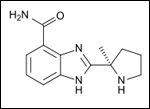Novel PARP Inhibitor for Solid Tumors and Lymphomas
Results of a Phase I study of the novel Poly(ADP-ribose) polymerase (PARP) inhibitor veliparib (ABT-888) in solid tumors and lymphoma have just been published in Cancer Research (doi:10.1158/0008-5472.CAN-11-1227).
Results of a Phase I study of the novel Poly(ADP-ribose) polymerase (PARP) inhibitor veliparib (ABT-888) in solid tumors and lymphoma have just been published in Cancer Research (doi:10.1158/0008-5472.CAN-11-1227). Veliparib was used in combination with topotecan, a chemotherapy agent that inhibits topoisomerase I.

Chemical formula of veliparib
This inhibition results in the prevention of DNA replication and leads to apoptosis. The combination of PARP and topoisomerase I inhibition is thought to prevent any repair of DNA damage during replication, resulting in more effective antitumor activity. Patients in this study had metastatic solid tumors or lymphoma. The goal of the early-stage trial was to see if the drug combination was tolerated and to find the maximum tolerated dose for the combination therapy.
This was the first clinical trial that showed significant reduction in PARP activity in three tumor biopsies compared with baseline after administration of veliparib. The results show that a PARP inhibitor is able to modulate the capacity to repair topoisomerase I-mediated DNA damage in the clinic. This modulation was seen in tumor samples as well as patient peripheral blood mononuclear cells and circulating tumor cells.
Patients were enrolled in a traditional 3+3 Phase I design. A total of 24 patients were enrolled. All had previous standard therapies for their diagnosed cancer. The maximum tolerated dose was found to be 0.6mg/m2 per day on days 1 through 5 and ABT-888 at 10 mg twice a day on days 1 through 5 in 21-day cycles. No evidence of significant pharmacokinetic interaction of the two drugs was observed. Pharmacokinetic analyses found that addition of ABT-888 to topotecan did not alter the half-life or clearance of topotecan.
Myelosuppression was the main exhibited toxicity, which is consistent with the neutropenia and thrmbocytopenia seen with topotecan monotherapy in lung and ovarian cancer patients. The authors believe that it is not possible to draw conclusions about the contributing toxicity of veliparib in this context. Interestingly, tolerance of the combination therapy in xenografts did not directly translate to the patient setting as mice bone marrow progenitors have a much higher tolerance to topotecan compared to their human counterparts.
Several inhibitors of PARP are currently being investigated in clinical trials for multiple types of cancers. Specifically, cancers with mutations in BRCA1 and BRCA2 may be more susceptible to PARP inhibition. As these mutated tumor cells have impaired double-stranded repair function, inhibiting PARP should result in persistant single-stranged breaks or nicks, which will lead to apoptosis. Additionally, cancer cells that lack PTEN may be more readily susceptible to PARP inhibition, as PTEN may function in the homologous recombination pathway.
An important question that still needs to be addressed is whether the combination of reduced topotecan dosage and a PARP inhibitor will increase the benefit-to-risk ratio of a higher topotecan dose. Potentially, a therapeutic benefit will be seen in patients with tumors that harbor DNA repair deficiencies such as BRCA or PTEN mutations. Analyses of patient tumor samples for mutations in DNA repair genes prior to and after treatment will at least partly address this question.
Also yet to be determined is the duration of exposure to PARP inhibitors that's necessary for the manifestation of clinical benefit.
Other PARP inhibitors currently in clinical trials include iniparib for lung cancer and ovarian cancer and olaparib for breast, ovarian, and colorectal cancer. Veliparib is currently in phase II trials for liver cancer, ovarian cancer, colorectal cancer, breast cancer, and melanoma. It is in phase I trials for prostate and cervical cancer as well as refractory central nervous system tumors in young adults.